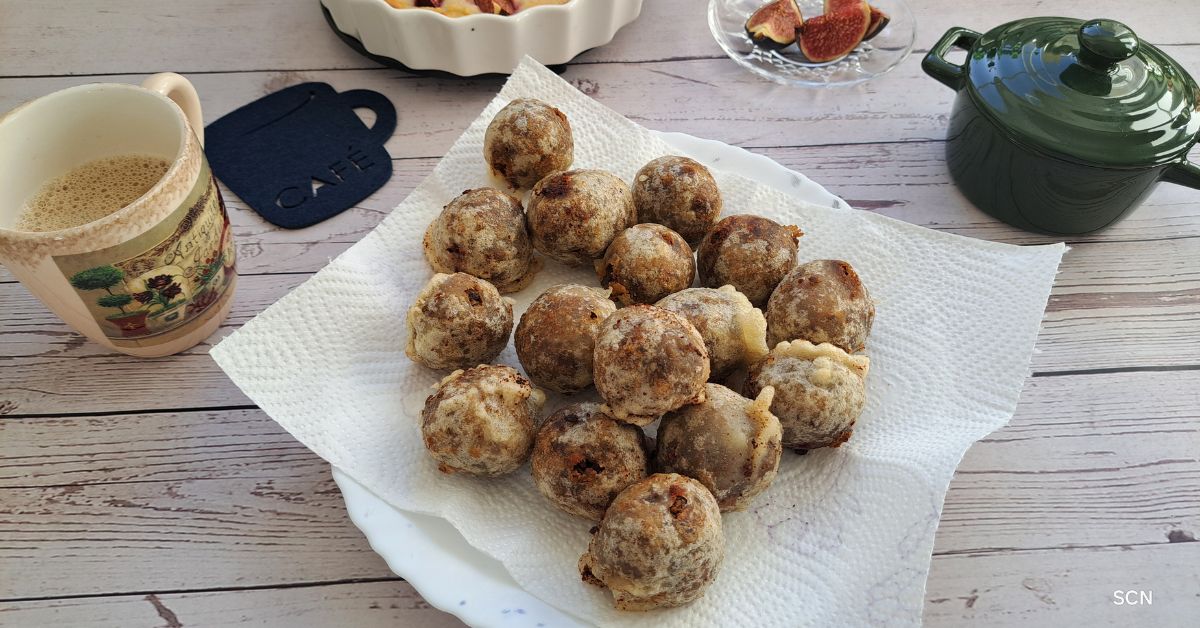Susiyam or Sukhiyan

Susiyam, also known as Suyyam or Sukhiyan, is a delicious South Indian sweet treat made during festive occasions like Diwali, Pongal, and other celebrations. This crispy, golden-brown snack has a soft, sweet filling made from lentils, jaggery, and coconut, wrapped in a batter made from rice or all-purpose flour, and deep-fried to perfection. Its simplicity and satisfying flavour have made it a favourite in many homes across Tamil Nadu, Kerala, and Karnataka.
Susiyam is a part of traditional South Indian cuisine. It is a popular sweet prepared especially in Tamil households during festive seasons. Though variations of this dish exist, the core ingredients remain the same, jaggery, coconut, and lentils, all commonly found in Indian kitchens. The dish has been passed down through generations, and its appeal lies in the blend of the nutty flavour of lentils, the sweetness of jaggery, and the crisp outer layer.
Ingredients Used in Susiyam
The main ingredients in Susiyam are:
Chana Dal (Bengal Gram) or Green gram: This lentil is boiled and mashed to form the base of the sweet filling. Its earthy taste pairs well with jaggery.
Jaggery: Known for its deep, caramel-like sweetness, jaggery adds a rich flavour to the filling. It is also healthier than refined sugar.
Grated Coconut: Fresh coconut adds a touch of texture and enhances the taste of the filling.
Rice Flour or Maida (All-Purpose Flour): The outer batter is made from either rice flour, maida or a mixture of both which gives Susiyam its signature crispy coating.
Cardamom: A pinch of ground cardamom elevates the filling with its warm, aromatic flavour.
Explore our delicious collection of snack recipes, perfect for any occasion, and elevate your tea time with these irresistible treats!
Susiyam preparation
To prepare Susiyam, the green gram or chana dal is first cooked until soft and then mashed. Mix the mashed dal with grated coconut, jaggery, and cardamom to form the filling. Shape small balls from this mixture. Next, prepare a batter by mixing rice flour and maida with water until smooth. Dip the filling balls into the batter, then deep-fry them in hot oil until golden brown. Once fried, drain them on a paper towel to remove excess oil, and they are ready to be served.
Popular Variations
Different regions of South India have slight variations in the recipe. In some areas, chana dal is used instead of green gram (green moong dal) for the filling. Some households also add sesame seeds to the filling for added texture. The batter might also vary, with some preferring a thicker or thinner coating depending on taste preferences.
Serving Susiyam
You can serve them warm, either as a dessert or a snack. It pairs well with a cup of hot coffee or tea. The crispy outer layer and the soft, sweet filling inside create a delightful contrast of textures and flavours that melt in the mouth.
This simple yet flavourful dish is sure to bring joy during festive times or as a special treat to share with family and friends. Susiyam is not just a festive dish, it’s a nostalgic reminder of home-cooked goodness. With its traditional roots and straightforward preparation, it continues to be a favourite among sweet lovers.
Tips
Cook the Dal Properly:
Use chana dal or green whole moong dal for the filling. Cook the green gram until it’s soft but not mushy. It should still hold its shape and not turn into a paste.
Drain excess water completely after cooking to avoid sogginess in the filling.
Mash the Dal:
After cooking the dal, mash it a bit. You can use the back of a spoon. Add jaggery only after mashing the dal. This helps in evenly distributing the sweetness.
Adjust the Sweetness:
The sweetness of susiyam depends on personal preference. You can adjust the quantity of jaggery based on how sweet you want it to be.
Always melt and strain the jaggery to remove impurities before adding it to the dal mixture.
Spices for Flavour:
Adding cardamom powder and grated coconut to the filling gives susiyam a fragrant, authentic flavour.
Prepare a Smooth Batter:
The batter for dipping the filling should be similar to dosa batter and smooth. If desired, use a mixture of rice flour and all-purpose flour with a pinch of turmeric for colour. Make sure there are no lumps.
Add a little salt to the batter to balance the sweetness.
Coating Evenly:
Dip the filling balls into the batter and ensure you coat them evenly. Too much batter will make it thick, while too little will make it crack during frying.
Frying in Medium Heat:
Fry the susiyam in medium heat to get a golden, crispy exterior without burning them. Frying in too high heat will result in an uncooked interior and an overcooked exterior.
Drain the fried susiyams on paper towels to remove excess oil.
Storage:
Susiyam tastes best when eaten fresh, but you can store them in an airtight container for a day. If you want to make them ahead, prepare the filling in advance and store it in the fridge until ready to fry.




Susiyam or Sukhiyan
Ingredients
1 Cup = 250ml
For the filling:
- 1 cup green gram dal (green moong dal)
- ½ cup grated coconut
- 1 cup jaggery
- ½ teaspoon cardamom powder
- 1 tsp ghee
- A pinch of salt
- Water as needed
For the batter:
- ¾ cup all-purpose flour maida
- 1 tbsp rice flour optional, for extra crispiness
- Water as required to make the batter
- A pinch of salt
- Oil for deep frying
Instructions
- Dry roast the green gram (moong dal) in a pan on medium heat until it turns slightly golden and releases a fragrant aroma. Keep stirring to avoid burning.
- Pressure cook the green gram. Use a 1:2 ratio of green gram to water and pressure cook for 5 whistles on medium flame. This will ensure the green gram is cooked to the right texture for the filling.
- Drain any excess water and mash it well.
- In a pan, melt the grated jaggery with ¼ cup of water until it dissolves completely.
- In a pan, add a teaspoon of ghee, the mashed green gram and a pinch of salt.
- Strain and add the melted jaggery and grated coconut. Mix and combine.
- Add the cardamom powder. Stir continuously until the mixture thickens and comes together like a dough.
- Turn off the heat and let the mixture cool down. Once cooled, make small lemon-sized balls from the mixture.
Prepare the batter:
- In a mixing bowl, combine the all-purpose flour, rice flour (if using) and a pinch of salt. Add water gradually and whisk to make a thick batter. It should be similar to dosa batter consistency.
Fry the Susiyam:
- Heat oil in a deep frying pan.
- Dip each jaggery-coconut ball into the batter, coating it evenly. Gently drop the coated balls into the hot oil.
- Fry on medium heat until golden brown and crispy on the outside.
- Remove from oil and drain excess oil on a paper towel.
- Your Susiyam is ready! Serve warm as a tea-time snack.
Notes
Frequently Asked Questions
The filling is made from cooked chana dal or moong dal, jaggery, grated coconut, and cardamom powder. The ingredients are combined and cooked to form a thick, sweet mixture.
Yes, you can substitute moong dal with chana dal for a softer texture and a slightly different taste. Both versions are equally delicious.
To avoid a mushy filling, cook the dal until it’s soft but still holds its shape. Drain the water completely after cooking, and mash it gently before mixing it with jaggery and coconut.
To ensure clean jaggery syrup, melt the jaggery with a little water, strain it to remove impurities, and then mix it into the mashed dal.
The batter should have a smooth, thick consistency to coat the filling properly. If it’s too thick, add a little water. If it’s too thin, add some more flour to thicken it.
Yes, you can prepare the filling in advance and store it in the fridge for a day or two. Fry the susiyams fresh for the best taste and texture.
Fry the Susiyam in medium heat to get a crispy exterior. If the oil is too hot, the outer layer will brown too quickly, and if it’s too cold, the susiyam may absorb excess oil.
Store leftover susiyam in an airtight container at room temperature for a day. For longer storage, keep it in the refrigerator and reheat it before serving.
Serve them on its own as a sweet snack or dessert. However, it pairs well with a cup of tea or coffee, especially during festive times.
